Scotland's Labour Market: People, Places, and Regions - Statistics from the Annual Population Survey 2019
Summary publication of results from the Annual Population Survey 2019, presenting analysis on the labour market, education and training.
This document is part of a collection
Section 1: Employment
1.1 Overview
In 2019, 2,759,700 people aged 16 years and over were economically active in Scotland. Scotland's economic activity rate (16 to 64) in 2019 was 77.5 per cent, lower than the UK rate of 78.8 per cent.
Who is classed as economically active?
Economically active individuals are those who are in employment or have been actively seeking work and are available to start work (an International Labour Organisation (ILO) definition).
Of the population aged 16 years and over in Scotland in 2019: 2,663,900 were in employment and 95,800 were unemployed.
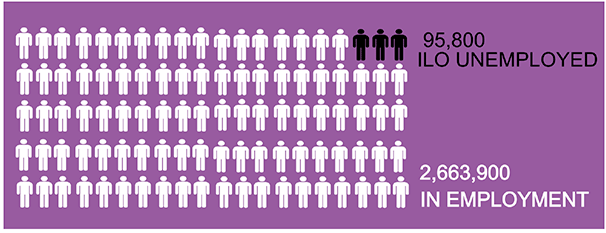
As in the UK, the employment level and rate (16 years and over) in Scotland were the highest in the series.
In 2019, the employment rate (16 to 64) was 74.8 per cent, slightly lower than the UK rate of 75.6 per cent.
Who is classed as being in employment?
If a person is over 16 years old and has done at least one hour of paid work in the week prior to their Labour Force Survey (LFS) interview or have a job that they are temporarily away from.
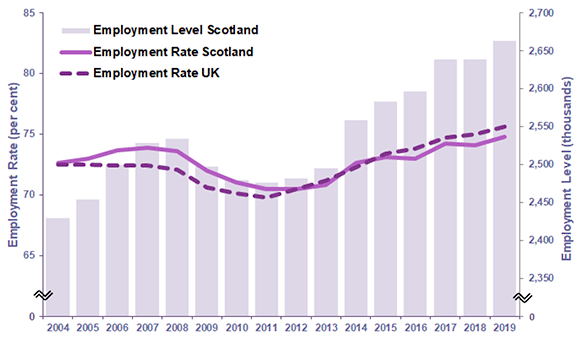
1.2 Local Authorities
There is considerable variation in employment rates for those aged 16 to 64 across Scotland's local authorities.
In January to December 2019
The highest employment rates were seen in:
- Orkney Islands (87.1 per cent);
- Perth and Kinross (83.4 per cent); and,
- Na h-Eileanan Siar (82.3 per cent).
The lowest employment rates were seen in:
- Glasgow City (67.3 per cent);
- Inverclyde (68.3 per cent); and,
- Dundee City (68.6 per cent).
Since 2009, the employment rate has increased in 28 local authority areas and decreased in four.
The local authorities seeing the largest increase in the past ten years were:
- Na h-Eileanan Siar (up 11.0* percentage points);
- Perth and Kinross (up 8.0* percentage points); and,
- East Ayrshire (up 7.1* percentage points).
While the four local authorities which decreased were:
- Shetland Islands (down 7.2 percentage points);
- Highland (down 3.1 percentage points);
- Moray (down 2.8 percentage points); and,
- Stirling (down 0.2 percentage points).
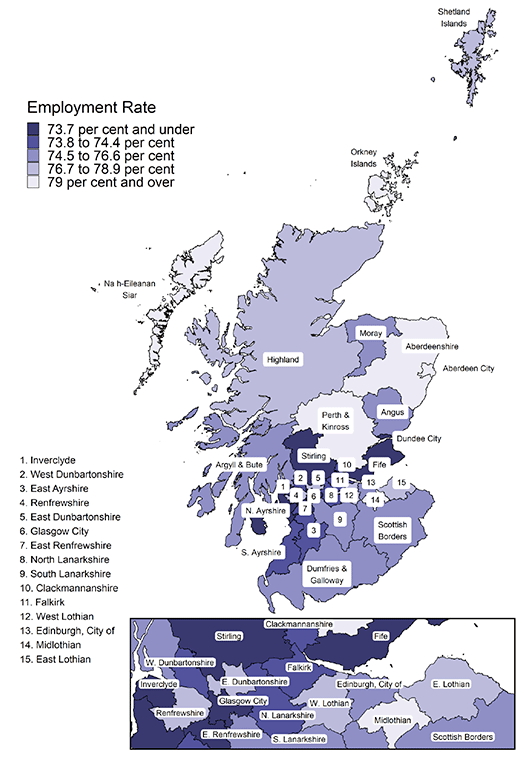
* Statistically Significant.
1.3 Gender
National Performance Framework Indicator
Gender balance in organisations
The gender employment gap is the difference between the employment rate for men and women. The gap decreased from 8.2 percentage points in 2009 to 7.6 percentage points in 2018 and further over the year to 6.3 percentage points in 2019.
From 2011 to 2015, the employment level and rate have increased at a faster rate for women compared with men in Scotland. However, since then the rate of increase has been similar for women and men.
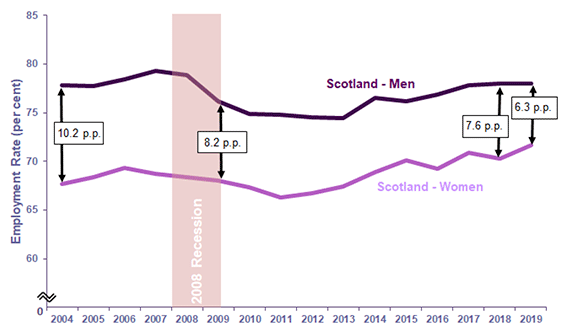
1,300,500 women were in employment in 2019, 97,100 more compared with 2009. The employment rate for women has increased by 3.8* percentage points from 68.0 per cent in 2009 to 71.7 per cent in 2019.
1,363,400 men were in employment in 2019, 69,100 more compared with 2009. The employment rate for men has increased by 1.8* percentage points from 76.2 per cent in 2009 to 78.0 per cent in 2019.
While the employment rate of women (16 to 64) is at a peak the employment rate of men (16 to 64) was higher between 2006 and 2008.
* Statistically Significant.
1.4 Local Authority areas
In 2019, men had higher employment rates (16 to 64) than women across all local authorities in Scotland, except Na h-Eileanan Siar and West Dunbartonshire, where women had higher employment rates than men, with employment rate gaps of -6.3 percentage points and -1.2 percentage points respectively.
Since 2009, the employment rate for women has increased in 27 of the 32 local authorities whereas for men the employment rate had increased in only 21 of the 32 local authorities.
In 2019 the highest gender employment gap was in Moray at 15.9 percentage points, with an employment rate of 66.9 per cent for women compared with a rate of 82.8 per cent for men.
Shetland Islands had the second highest with a gender employment gap of 13.5 percentage points, with an employment rate of 70.5 per cent for women compared to 84.0 per cent for men.
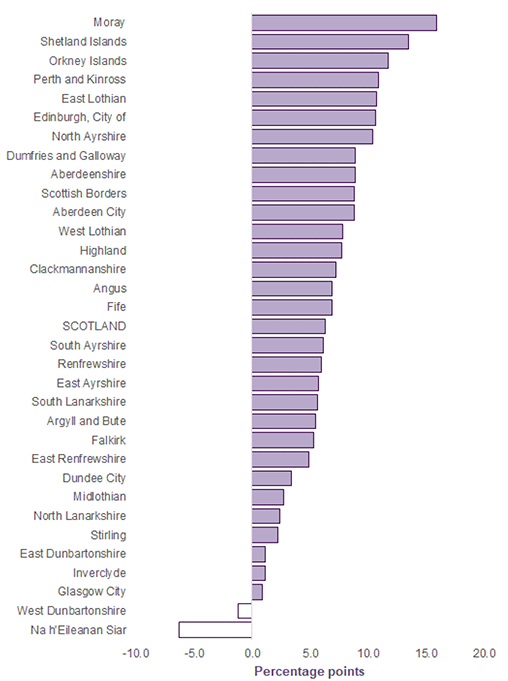
1.5 Age
In the last year the employment rate has increased in all age bands up to 65 years .
The employment rate for young people (16 to 24) has increased over the last year to 57.9 per cent of those aged 16 to 24 being in employment. The 2008 recession had greatest impact on the employment rates of young people reducing from 60.7 per cent in 2008 to a low of 52.7 per cent in 2013.
The employment rate for 25 to 34 year olds (81.6 per cent) and 35 to 49 year olds (84.0 per cent) have been fairly stable in the period 2004 to 2019. Although slightly lower in the years 2010 to 2012.
The employment rates for those aged 50 to 64 have increased throughout the economic recovery and in each year since 2012 reaching a record high of 70.5 per cent in 2019.
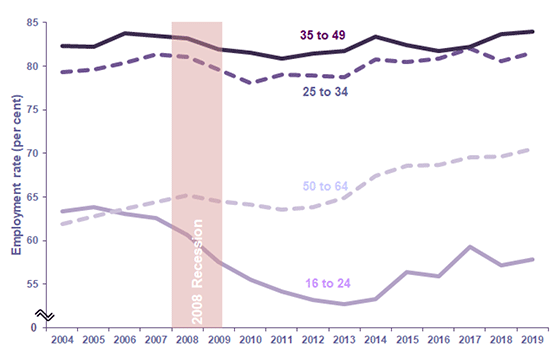
Similarly the employment rate for those aged 65 years and over has increased since 2004 from 5.2 per cent, however has decreased in the last year slightly to 8.7 per cent in 2019.
Full–Time Education
The level and rate of people who self-reported participating in full-time education in the APS has changed over time and was highest in the years 2011 to 2015 when, in each year, over 320,00 people were in full time education.
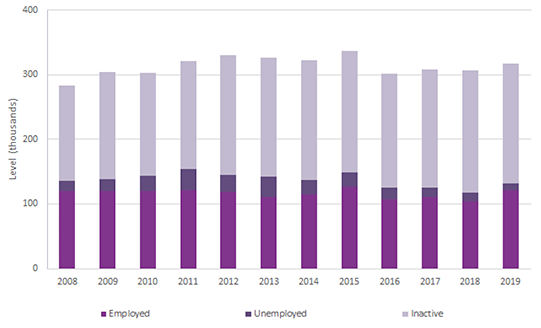
In 2019, 44.2 per cent of the population aged 16 to 24 and 9.2 per cent of those aged 16 to 64 were in full-time education.
61.6 per cent of people in full-time education were not employed whilst studying.
Excluding those in full-time education, the employment rate of those aged 16 to 64 in 2019 increases to 78.6 per cent.
1.6 Ages 16 to 24
The youth (16 to 24) employment rate in Scotland increased by 0.7 percentage points over the year from 57.2 per cent in 2018 to 57.9 per cent in 2019.
While the UK rate increased by 0.4 percentage points from 53.7 per cent to 54.1 per cent over the same period.
The local authority areas with the highest youth employment rates in Scotland in 2019 were:
- Orkney Islands (82.0 per cent);
- Na h-Eileanan Siar (75.9 per cent); and,
- Aberdeen City (73.0 per cent).
The local authority areas with the lowest youth employment rates in Scotland in 2019 were:
- East Renfrewshire (38.5 per cent);
- Glasgow City (47.5 per cent); and,
- Inverclyde (49.8 per cent).
It should be noted that youth employment rates in university areas are likely to be lower due to higher levels of economically inactive students.
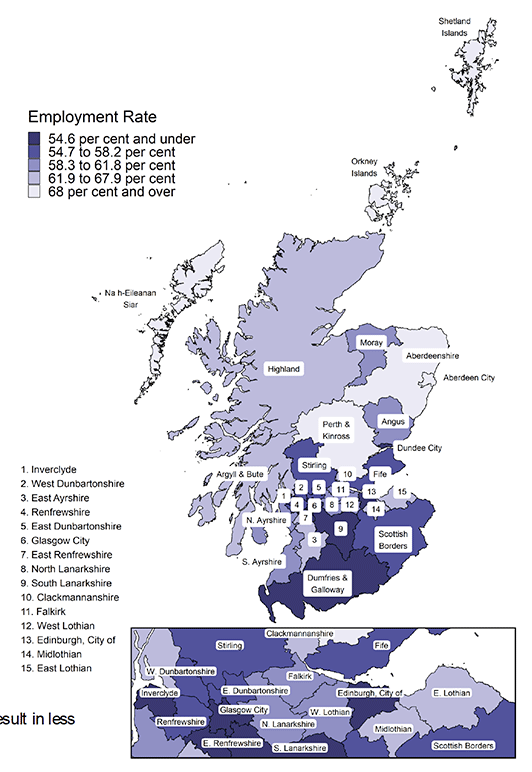
Shetland estimates are based on a small sample size. This may result in less precise estimates, which should be used with caution.
1.7 Ages 50 and over
50 to 64 years
The employment level for those aged 50 to 64 years increased by 146,700 from 642,200 in 2009 to 788,900 in 2019. The employment rate increased 6.0* percentage points from 64.5 per cent to 70.5 per cent over the same period.
Women accounted for nearly two thirds (59.0 per cent) of the increase in employment level for those aged 50 to 64.
65 years and over
89,100 people aged 65 and over were in employment in Scotland in 2019, nearly two thirds (62.7 per cent) more than ten years ago.
The most common reason for working past the age of 65 years was overwhelmingly being "Not ready to stop working" reported by
58.8 per cent.
50 years and over
The local authorities with the highest employment rate for those aged 50 years and over were:
- Shetland Islands (52.4 per cent);
- Orkney Islands (50.3 per cent); and,
- Highland (46.1 per cent).
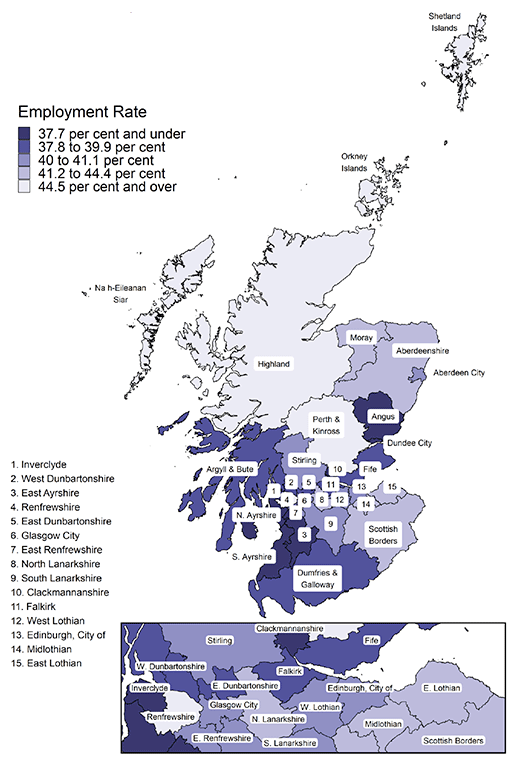
1.8 Age by Industry
Almost a quarter of people aged 16 to 24 in employment are work in "Wholesale, Retail, Repair of Vehicles"; accounting for 22.3 per cent of the workforce in this sector.
Almost 1 in 5 are employed in "Accommodation and Food Services", accounting for 36.8 per cent of all employed in this sector.
Almost 1 in 10 are employed in "Health and Social Work activities", however young people only account for 7.6 per cent of employment in that sector.
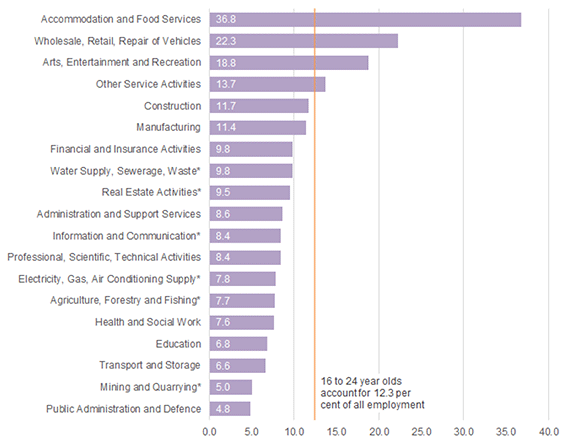
*Estimates are based on a small sample size. This may result in less precise estimates, which should be used with caution
While young people account for 12.3 per cent of all in employment, the 50 to 64 year old age band accounts for one third of the workforce.
The highest proportion of the population aged 50 years and over work in "Health and Social Work" where 140,200 people in this age group are employed in the sector accounting for 35.1 per cent of all employed in that sector.
People in employment aged 50 years and over account for over 40 per cent of the workforce in "Agriculture, Forestry and Fishing", "Transport and Storage", and "Water Supply, Sewage, Waste".
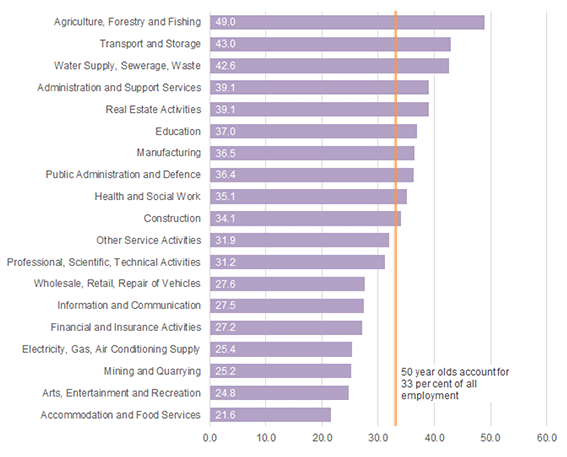
1.9 Health and Disability
In 2019, the employment rate for those classed as disabled under the Equality Act 2010 was 49.0 per cent which is significantly lower than the employment rate for non-disabled people (81.6 per cent). In 2019, the disability employment gap was 32.6* percentage points.
Data on disability
The disability employment gap is the difference between the employment rates of disabled people and non-disabled people. It is calculated as the non-disabled employment rate minus disabled employment rate.
The gap between the employment rate for disabled and non-disabled people has decreased by 2.9 percentage points over the year and by 4.7 percentage points since 2016.
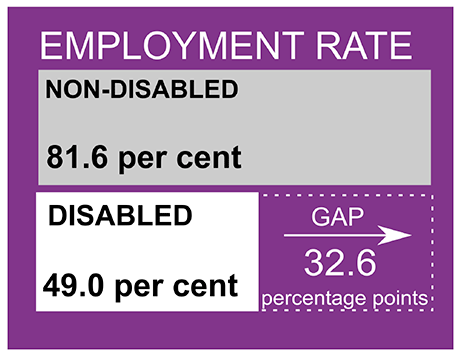
The employment rate for disabled people increased from 45.6 per cent in 2018 to 49.0 per cent in 2019, and was the primary reason for the reduction in the employment gap as the employment rate for non-disabled people increased only slightly from 81.1 to 81.6 per cent over the same period.
The disability employment gap was lower for women (27.5 percentage points) than men (38.2 percentage points) for ages 16 to 64 and across all other age bands.
The disability employment gap was lower for young people and increased with age with the gap being highest for those aged 50 to 64 years, for both women and men.
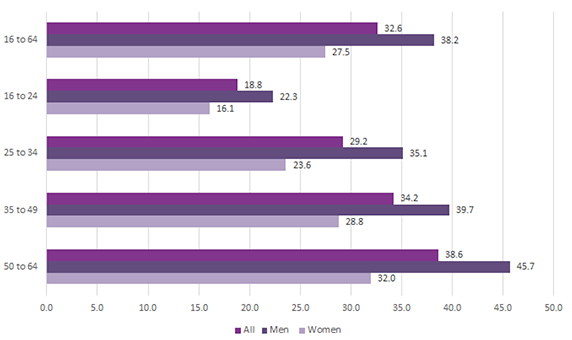
* Statistically Significant
1.10 Health and Industry
12.2 per cent of the workforce have a self-reported long-term condition (lasting 12 months or more) which can include respiratory, cardiovascular, diabetes or a progressive illness. These conditions are highlighted as they may relate to greater susceptibility to the effects of COVID-19.
Those industries with the highest proportion of their workforce reporting at least one of the four long-term condition are "Transport and Storage" (including warehousing) and "Water Supply, Sewerage and Waste" sectors with over 14 per cent.

* Estimates are based on a small sample size. This may result in less precise estimates, which should be used with caution.
** Estimates are limited to people who self-reported any of the four long-term conditions including respiratory, cardiovascular, diabetes, or a progressive illness.
1.11 Ethnicity
The employment rate for the minority ethnic population aged 16 to 64 was 59.3 per cent. This is lower than the rate for white population (75.7 per cent) giving a gap in employment rates between minority ethnic and white of 16.4 percentage points.
The white population has consistently had an employment rate that exceeds the minority ethnic population.
The minority ethnic employment gap was much higher for women than men. For women the gap was 22.0 percentage points and for men it was 9.5 percentage points.
The gap in the employment rate for the minority ethnic population was largest for ages 16 to 24 (26.1 percentage points); followed by ages 25 to 34 (25.3 percentage points), ages 35 to 49(15.0 percentage points), and ages 50 to 64 (3.1 percentage points).
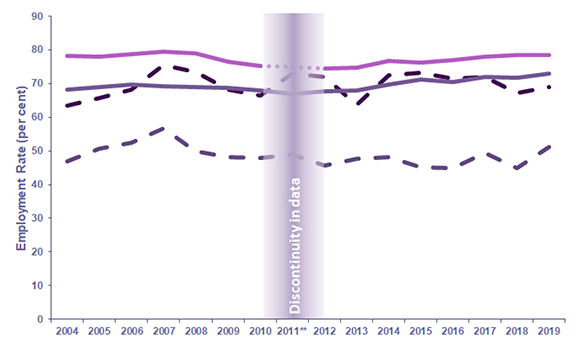
Contact
Email: LMStats@gov.scot
There is a problem
Thanks for your feedback